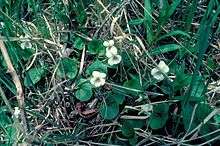Viola renifolia
| Viola renifolia | |
|---|---|
 | |
| Scientific classification | |
| Kingdom: | Plantae |
| (unranked): | Angiosperms |
| (unranked): | Eudicots |
| (unranked): | Rosids |
| Order: | Malpighiales |
| Family: | Violaceae |
| Genus: | Viola |
| Species: | V. renifolia |
| Binomial name | |
| Viola renifolia A.Gray | |
Viola renifolia is a species of violet known by the common names white violet and kidneyleaf violet. It is native to northern North America, where it has a widespread distribution across Canada and the northern United States as far south as Washington, Colorado, and New York.[1]
This plant is a perennial herb growing up to 10 centimeters tall. It does not have stems, rhizomes, or stolons. The kidney-shaped leaf blades are 3 to 6 centimeters long and are borne on petioles up to 15 centimeters long. The flower is 1 to 1.5 centimeters long and white in color with purple lines on the lower three petals. The fruit is a purplish capsule.[1][2]
This violet grows in white spruce and black spruce forests, and temperate coniferous forests. Near the Great Lakes it grows in swamps and wooded areas.[1]
References
- 1 2 3 Williams, Tara Y. 1990. Viola renifolia. In: Fire Effects Information System, [Online]. U.S. Department of Agriculture, Forest Service, Rocky Mountain Research Station, Fire Sciences Laboratory.
- ↑ Viola renifolia. The Nature Conservancy.
